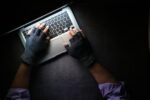Cybersecurity in Everyday Life: Why Digital Protection Matters More Than Ever

In a world where smartphones double as wallets, cloud storage holds our most personal documents, and social media archives our lives, cybersecurity has shifted from a niche concern to an everyday need. No longer reserved for IT professionals or government agencies, digital protection now affects everyone—from students and freelancers to businesses and families.
The last decade revealed the world’s vulnerability to data breaches, phishing scams, and identity theft. At the same time, the rise of remote work, online banking, streaming platforms, and casual gaming has expanded our digital footprint.
Each click, login, and data transfer represents an opportunity for compromise. This is why cybersecurity matters more than ever. It’s no longer about avoiding hackers in hoodies, but about protecting the fabric of modern life.
The Expanding Digital Landscape
The sheer scale of digital activity makes cybersecurity unavoidable. From social networks and e-commerce to healthcare apps and smart home devices, each service collects sensitive data. Add in cloud-based collaboration tools for remote jobs and entertainment platforms like streaming or online games, and the web of personal exposure grows exponentially.
This interconnectedness highlights a crucial reality: cybersecurity isn’t just about the big breaches making headlines. It’s about everyday online safety, from securing email accounts with two-factor authentication to avoiding malicious links in direct messages.
Cybersecurity as Daily Hygiene
Think of cybersecurity as personal hygiene for the digital age. Just as we brush our teeth daily, small protective habits can prevent long-term damage. These include:
- Strong, unique passwords for every account.
- Two-factor authentication (2FA) wherever possible.
- Regular software updates to patch vulnerabilities.
- Awareness of phishing attempts via suspicious emails or texts.
- Using VPNs on public Wi-Fi for added internet privacy.
These habits may seem routine, but they form the backbone of digital self-defence. Skipping them is the equivalent of skipping vaccinations—small lapses that open the door to greater risks.
The Psychology of Cyber Threats
Not all attacks are brute force hacks. Increasingly, cybercriminals rely on exploiting human behaviour. Known as social engineering, these tactics manipulate trust and curiosity. Clicking on a fake “delivery status” email or accepting a friend request from an impersonated profile can lead to data theft or malware downloads.
This psychological angle makes cybersecurity as much about awareness as it is about firewalls and antivirus software. Training individuals—employees, students, or seniors—on recognising manipulative tactics is one of the most effective ways to reduce risks.
Internet Privacy in a Connected Age
With billions of people online, internet privacy is becoming one of the central concerns of the 21st century. Every search query, purchase, and GPS check-in creates data trails. While this fuels personalisation and convenience, it also opens doors for misuse—whether through aggressive advertising, political profiling, or malicious data leaks.
Strong cybersecurity tools like encrypted messaging apps, privacy-first browsers, and ad-blocking extensions are rising in demand. Yet, individuals also need to practice discernment. Adjusting privacy settings on social platforms, limiting app permissions, and being mindful about sharing location data are small actions that compound into stronger protection.
Cybersecurity at Work and Play
For many, the line between work and personal life is blurred. A remote employee might switch between handling confidential files and streaming a live concert, or even playing casual online games. Each activity carries cybersecurity implications.
- At work, companies implement secure networks, cloud encryption, and team training on digital regulation compliance.
- At home, individuals must consider the risks of connected devices—smart speakers, IoT appliances, and even children’s toys.
Even leisure is not exempt. Streaming accounts, mobile puzzles, and casual gaming platforms often store personal details or payment info. That makes choosing verified, secure platforms a crucial part of everyday online safety.
Digital Regulation: Governments Step In
Governments worldwide are realising that cybersecurity is not just a personal issue but a matter of national resilience. New digital regulation frameworks are emerging to govern cross-border data flows, impose stricter standards on corporations, and protect citizens’ rights.
For instance, Europe’s GDPR (General Data Protection Regulation) set global benchmarks on data transparency and user consent. Countries like India are adopting their own digital protection acts, while the U.S. is considering stricter frameworks for tech giants.
This trend is reshaping industries from finance to entertainment, forcing companies to align with new privacy requirements. For individuals, it means more rights—but also the responsibility to understand what protections are available and how to use them.
The Cost of Neglect
Neglecting cybersecurity comes at a high price. Identity theft, fraudulent transactions, and ransomware attacks cost individuals and businesses billions annually. Beyond financial losses, breaches can damage reputations and erode trust in institutions.
One overlooked consequence is emotional stress. Victims of hacks or scams often feel violated, anxious, and hesitant to engage online. This psychological toll further underscores why cybersecurity should be framed not as a technical add-on but as a core pillar of modern well-being.
Building a Culture of Cyber Awareness
Ultimately, the fight against digital threats isn’t just about stronger firewalls or smarter AI detection systems. It’s about fostering a culture of cyber awareness. Schools, workplaces, and communities must normalise discussions around cybersecurity in the same way we discuss physical safety or financial literacy.
The more people understand cues, routines, and risks, the less vulnerable they are. Cyber resilience is collective: if even one person in a workplace or family falls for a phishing scam, it can compromise the entire network.
Living Safely in the Digital Age
As digital life expands, cybersecurity is no longer optional. It’s survival.
Each message sent, device connected, and platform joined is part of an intricate web of risk and reward. By embracing small habits, respecting internet privacy, and supporting stronger digital regulation, individuals can take control of their safety.
The age of cybersecurity is not a distant future. It’s now. And the choices we make today, from enabling two-factor authentication to staying informed about threats, will determine how secure our digital lives remain tomorrow.








